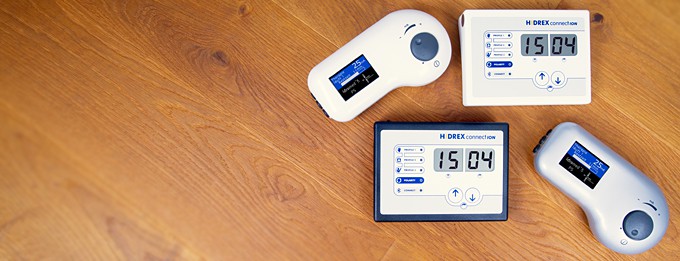Sweat odor
Sweat smells - prevent body odor and the smell of sweat
Body odor, also known as sweat odor, is an unpleasant smell that occurs due to the sweating of the body.
When we sweat, our sweat glands produce fluid that is mainly composed of water.
Sweat itself doesn't have a smell, but when it is broken down by the bacteria on our skin, not only do these bacteria multiply, but they also produce odors through metabolic byproducts.
Bacteria on our skin form a kind of natural ecosystem known as the skin microbiome. When we sweat, we create a moist environment in which bacteria can thrive. These bacteria then break down the proteins and fatty acids present in sweat, which can lead to unpleasant odors.
Sweat can be reduced with iontophoresis.
For testing purposes, our iontophoresis devices can also be rented at an affordable price.
The formula for iontophoresis is simple:
Less sweat → fewer bacteria → less odor!
There are various factors that can influence the severity of sweat odor. For example, it depends on the amount and type of bacteria on our skin, the type of clothing we wear, and our physical activity.
Clothing plays an important role in the formation of sweat odor. When we wear clothing, a portion of the sweat is absorbed and remains in the fabric. If this clothing remains damp, it provides an ideal breeding ground for bacterial growth, which can intensify the sweat odor. This is also known as the "wet dog syndrome".
One way to avoid sweat odor is to use clothing made of breathable fabrics such as cotton or linen. These materials allow air to pass through and facilitate a faster evaporation of moisture, thus reducing bacterial growth.
There are also several measures we can take to reduce sweat odor. This includes daily showering and the use of deodorants or antiperspirants. These products help reduce the number of bacteria on the skin and thus diminish the odor.
Overall, sweat odor is a natural phenomenon that arises from the sweating of the body.
By being aware of our clothing choices and practicing proper hygiene, we can contribute to the reduction of sweat odor, feeling fresher and, consequently, more confident.
Bromhidrosis - help, I'm smelly!
Bromhidrosis is a medical term that refers to strong and unpleasant body odor.
Severe bromhidrosis is an intense experience for those affected - and for the people around them!
Bromhidrosis cannot be simply eliminated through normal hygiene measures. This odor is caused by the bacterial breakdown of sweat on the skin in combination with contaminated clothing, and even washing with soap 20 times is often not enough.
After seconds, the odor returns, and it is highly frustrating.
There are two types of bromhidrosis: primary and secondary bromhidrosis.
Primary bromhidrosis is a rare condition in which the body produces an unusually strong and unpleasant odor even when a person follows good hygiene practices.
This form of bromhidrosis is caused by an overproduction of sweat in the apocrine sweat glands, which are mainly located in the armpits, groin area, anus, and nipples. This sweat secretion is rather thick and milky, so it differs from normal sweat.
Apocrine sweat glands are the ones that produce scents, like musk in musk oxen.
On the other hand, secondary bromhidrosis is the most common type and occurs when bacteria on the skin break down the sweat. This type of bromhidrosis can be caused by various factors such as poor hygiene, certain medications, or conditions like diabetes, kidney problems, or liver problems.
The treatment of bromhidrosis depends on the type and severity of the condition.
For secondary bromhidrosis, lifestyle changes such as more frequent showers, the use of antibacterial soaps and deodorants, wearing breathable clothing, and avoiding tight-fitting clothes can help reduce the odor.
In more severe cases, prescription or medical treatments such as topical or oral antibiotics, botulinum toxin injections, or surgical interventions may be considered.
Overall, bromhidrosis can be a highly distressing condition that can impact a person's self-confidence and social relationships. It is important to consult a doctor if regular hygiene measures are not sufficient to reduce the odor in order to find the best possible treatment option.



Underarm odor, foot odor, and smelly clothing are types of bromhidrosis or body odor caused by the bacterial breakdown of sweat on the skin.
Each type of bromhidrosis has its own specific causes and treatment options.
Underarm odor is mainly caused by the apocrine sweat glands in the armpits. Bacteria on the skin break down our sweat, resulting in an unpleasant smell.
It is surprising that dark clothing tends to smell worse than light clothing.
Black T-shirts are particularly prone to this phenomenon.
Foot odor is caused by bacteria on the skin and in the shoes that break down the sweat. Shoes and socks can retain moisture, which promotes the growth of bacteria.
To reduce the odor, it is important to wash and keep the feet dry on a daily basis, wear breathable shoes, and regularly change shoes and socks. Disinfectants for shoes and socks can also be helpful.
Odor in clothing occurs when sweat and bacteria remain in the fabric. Regularly washing your clothes with a suitable detergent can reduce the odor. It is also important to wear clothing made of breathable materials like cotton, and to avoid tight-fitting clothes.
In more severe cases of bromhidrosis, medical treatments such as topical or oral antibiotics, botulinum toxin injections, or surgical interventions may be considered.
However, it is always best to consult a doctor before making such decisions in order to find the best treatment option.
Overall, it is important to maintain good hygiene practices to effectively reduce unpleasant odor in a sustainable way.
Reduce smells - fight sweat
Where there is sweat, there is moisture. Moisture + warmth = bacteria
A problem, especially when wearing shoes: sweaty feet - reduce sweat
